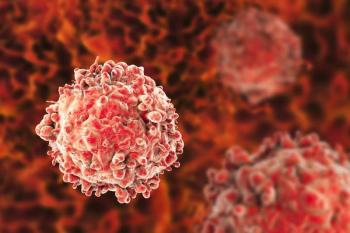
Highlighting Bispecific Use Across Multiple Myeloma Indications
Shebli Atrash, MD, stated that MRD should be considered carefully as an end point given potential recurrence despite MRD negativity.
In an interview with CancerNetwork®, Shebli Atrash, MD, medical oncologist at Levine Cancer Institute and clinical associate professor of medicine at Wake Forest University, discussed the presentation on T-cell engagers in multiple myeloma he gave at the 2025 National Immune Cell Effector Therapy Conference.1
Initially, he specified that his presentation covered already approved BCMA antibodies as well as indications for patients who have pan-refractory disease and resistance to all available treatment standards. Contextualized by an estimated 70% overall response rate in trials evaluating BCMA antibodies in multiple myeloma, Atrash suggested that investigators were evaluating this treatment in earlier lines of therapy.
Highlighting the phase 3 MajesTEC-7 trial (NCT05552222), Atrash noted that researchers are evaluating teclistamab-cqyv (Tecvayli) against the standard of care of daratumumab (Darzalex), lenalidomide (Revlimid), and dexamethasone—the MAIA trial (NCT02252172) regimen—in the transplant-ineligible population.2,3 Atrash further explained that researchers have explored the addition of teclistamab to daratumumab/lenalidomide with or without bortezomib (Velcade) for patients who are eligible for transplant in the US. Additionally, he expressed that he has observed deep responses following bispecific antibody use as induction therapy.
In the maintenance setting, Atrash noted that multiple trials are exploring bispecific use, including the phase 3 MajesTEC-4 trial (NCT05243797), which is evaluating teclistamab with lenalidomide vs lenalidomide alone.4 In the trial, Atrash explained that those characterized as having minimal residual disease (MRD)–negative status at baseline maintained MRD negativity after the third cycle of treatment. He concluded by suggesting that the use of MRD as an end point should be done carefully given potentially quick recurrence among patients with high-risk disease and disease progression among those who have standard-risk disease but have experienced slow responses.
Transcript:
We discussed bispecific antibodies for multiple myeloma. We went over the already approved BCMA antibodies [and] the indication for patients who are pan-refractory. [Trials evaluating BCMA antibodies] roughly showed us a 70% overall response rate with acceptable toxicity. The field is moving toward earlier lines; bispecific antibodies are being tested for early relapse as well as for newly diagnosed multiple myeloma. BCMA bispecific antibodies are [quite] effective for newly diagnosed multiple myeloma, whether [patients] are transplant eligible or ineligible. Trials have been testing for transplant-ineligible [disease], utilizing teclistamab in [the phase 3 MajesTEC-7 trial] against standard of care, which is the MAIA protocol of daratumumab, lenalidomide, and dexamethasone.
For the US, we are new to the trial. [Investigators have] been enrolling [outside the] US for some time now, and the trial is opening soon in the US. For transplant-eligible [disease], we have incorporated teclistamab enrichment with daratumumab/lenalidomide with or without bortezomib. More interesting to me is the concept of using those bispecific antibodies as a single agent for induction. It is [quite] convenient for patients as subcutaneous or [intravenous] administration, depending on the product. As a single agent, it seems to produce deep responses.
In the maintenance setting, there are a few trials that are looking at that as well. We have the [phase 3 MajesTEC-4 trial] that looked at teclistamab with lenalidomide vs lenalidomide alone, which is our standard of care. The initial safety run-in phase enrolled few patients, but all patients who were tested for MRD negativity [had] MRD-negative [disease] after cycle 3. This is promising. If we believe that MRD negativity is the end point to be, especially for newly diagnosed and standard-risk patients, then those regimens are delivering what we ask for.
However, we must always be careful when you use MRD as an end point, because patients with high-risk disease could relapse quickly and patients with standard-risk disease and slow response might still show some [progression] that does not reflect the risk assessment for their disease.
References
- Atrash S. Emerging T-cell engagers & novel immunotargets in multiple myeloma. Presented at: 2025 National Immune Cell Effector Therapy Conference; July 26, 2025; Orlando, FL.
- Krishnan AY, Manier S, Terpos E, et al. MajesTEC-7: a phase 3, randomized study of teclistamab + daratumumab + lenalidomide (Tec-DR) versus daratumumab + lenalidomide + dexamethasone (DRd) in patients with newly diagnosed multiple myeloma who are either ineligible or not intended for autologous stem cell transplant. Blood. 2022;140(suppl 1):10148-10149. doi:10.1182/blood-2022-160173
- Facon T, Kumar S, Plesner T, et al. Daratumumab plus lenalidomide and dexamethasone for untreated myeloma. N Engl J Med. 2019;380(22):2104-2115. doi:10.1056/NEJMoa1817249
- Zamagni E, Boccadoro M, Spencer A, et al. MajesTEC-4 (EMN30): a phase 3 trial of teclistamab + lenalidomide versus lenalidomide alone as maintenance therapy following autologous stem cell transplantation in patients with newly diagnosed multiple myeloma. Blood. 2022;140(suppl 1):7289-7291. doi:10.1182/blood-2022-159756
Newsletter
Stay up to date on recent advances in the multidisciplinary approach to cancer.
































































































